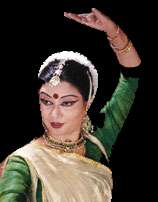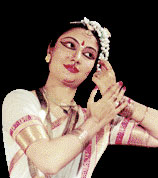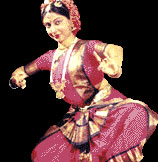|
• Kathak: 
Kathak was originated from a community called Kathakars or story tellers who would go town to town, reciting and dancing about gods and goddesses. In the course of time this dance came to be known as Kathak.
With the advent of Muslim rule Kathak slowly moved from the temple to the court. The main components of Kathak are Nritya (dance with expression) and Nritta (pure dance).
The pure dance passages are an opportunity for incredibly fast and precise foot work with hundreds of ankle bells producing a fantastic range of sound and rhythms. In the expression passages the dancers elequent interpretation of the peotic line is a test of improvisational skill.
Kathak is the remarkable fusion of Hindu temple and Muslim court room tradition where by the synthesis of Indian culture is reflected.
 •
Mohini Attayam: •
Mohini Attayam:
Mohini Attayam is the only dance which exclusively belongs to women and utterly feminine in its manner and component.
Mohini means attractive lady and Attyam means Dance. Mohini Attayam is originated from Kerala which is surrounded by the sea and full of coconut trees. The movement of sea and coconut trees is being incorporated in this dance form.
It was also taken from the dance of God Vishnu during his reincarnation as Mohini.
In many points Bharat - Natyam and Mohini - Attayam are similar. It has a preponderance of sensual element and carries an enduring vivacity that sometimes verges on coquettishness.
 •
Bharata Natyam: •
Bharata Natyam:
Bharata Natyam is the dance of Shiva which is a symbol of the creation and destruction of the universe. Bharat Natyam was performed in the temples of Shiva and originated from South India. It's antiquity goes to the Rigvedic Hymns. This gratious art form perpetuated and preserved by devdasis who used to dance before the image in the temples, the aim being perfection of spiritual identification.
This dance form was originated from Natya-Shastra written between the 2nd century B C and 2nd century A D by Bharat Muni of the first Guru in Art of Dance.
Bharat Natyam means BHA (Bhava - emotion) RA (raga - melody) and TA (Tala - rhythm)
|

